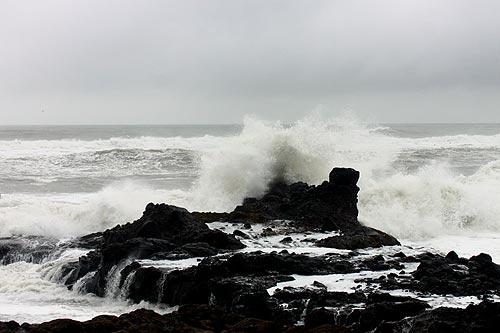Scientists: Erosion, Winter Storms Could Worsen Around World, Oregon Coast
Published 09/23/2015 at 5:24 AM PDT
By Oregon Coast Beach Connection staff

(Newport, Oregon) – El Nino and La Nina events may worsen storm severity and their erosional effects on more continents than just North America in the coming decades, along with more devastating flooding. This comes from a new set of findings from scientists working out of Oregon State University and the central Oregon coast's Hatfield Marine Science Center, who looked at data from 1979 to 2012.
Among the spookier and more far-reaching consequences of what scientists called these increased “seasonal water level anomalies” is that coastal populations around the world could be affected. Some general climate worst-case scenarios already look to the possibilities of millions of people being displaced by rising sea levels and flood damage topping the trillion dollar mark by the end of the end century. Still more predictions suggest La Nina and El Nino events will be on the rise, making these problems worse.
Closer to home, the researchers saw a pattern of more sand depletion and the potential for bigger floods along the Oregon coast.
The El Niño winters of 1982-83 and 1997-98 brought the most extreme flooding to the coasts of Washington and Oregon, said Peter Ruggiero, an Oregon State University coastal hazards expert and co-author on the study. With increased severity in El Nino events, the Pacific Northwest coastline will be looking at more erosion in winter or less of the sand build-up that normally occurs in summer. More heavy floods, like those that permantely ruined several commercial buildings in Tillamook in the last decade, could be on menu for the area.
“We’re in the midst of a strengthening El Niño right now,” Ruggiero said. “And we are already seeing some significant water level anomalies through tide gauge readings. Some people project that this 2015-16 El Niño could match those significant events of 1982-83 and 1997-98.”
The study found spots like Neskowin and the northern parts of Newport had a continued erosion pattern of more than one meter each year since the 60's. El Nino years often produced storms that reached the coast from a more southern, steep approach and caused some areas to be more affected than others.
Since the study stopped at data in 2012, it did not take into account the trend since 2011 for calmer winters where erosion was less and there was much bigger sand build-up in the summers. This year's high sand levels were particularly striking for many locals and officials.,This includes Keith Chandler of Seaside Aquarium, who earlier this year told Oregon Coast Beach Connection he's had to drastically heighten the facility's ocean water intake pipe to compensate.
The last three winters have seen far less appearances of the “ghost forests” - tree stumps more than 2,000 years old that are normally buries well below the sand. These started to make bigger showings in the 2000's in areas around Newport and Cape Looikout State Park, but abruptly stopped.
The National Weather Service (NWS), in the meantime, is predicting this El Nino to cause a much drier and less stormy winter for the Northwest. The findings of Ruggiero and his team could still mean stronger storm events, when they do happen.
More Oregon coast storm action and the ghost forests below:




More About Oregon Coast hotels, lodging.....
More About Oregon Coast Restaurants, Dining.....
LATEST Related Oregon Coast Articles
Likely just before dawn best hour but peak happens during daylight. Weather
Dark Sky Week is Prime Along Oregon Coast: Where and Where Not to Go
General guide to dark sky viewing from south to north coast. Astronomy
Sizable Price Drop, Deals in Lincoln City During Quiet of April on Central Or...
20 perc off at A1 Vacation Rentals across its roster, including Gleneden Beach. Lincoln City specials
Upcoming S. Oregon Coast Events Include Gem Show, History: Coos Bay, Bandon
May 6 talk at Coos History Museum, Mayfly Fest May 17, Bandon Rock / Gem Show June 7,8
Washington Coast Cleanup on April 19 - Coinciding with Oregon Coast's SOLVE E...
From the Puget Sound to Long Beach, alongside Oregon's cleanup. Washington coast events, Seaside events
Astoria's Riverwalk Gets New Lighting, More N. Oregon Coast Roadwork
Delays coming this summer, but the riverwalk has a new look. Seaside, Cannn Beach
April Gets Even Cheaper Midweek at Depoe Bay, Lincoln City: Oregon Coast Deals
Off-season rates plus more at Keystone Vacation Rentals. Depoe Bay lodging specials, Lincoln City hotel reviews, Newport hotel reviews
Washington Coast Begins Week of Clam Digs, April 12 Through 18
Long Beach, Twin Harbors, Mocrocks and Copalis at different times. Washington coast events
Back to Oregon Coast
Contact Advertise on BeachConnection.net
All Content, unless otherwise attributed, copyright BeachConnection.net Unauthorized use or publication is not permitted












































